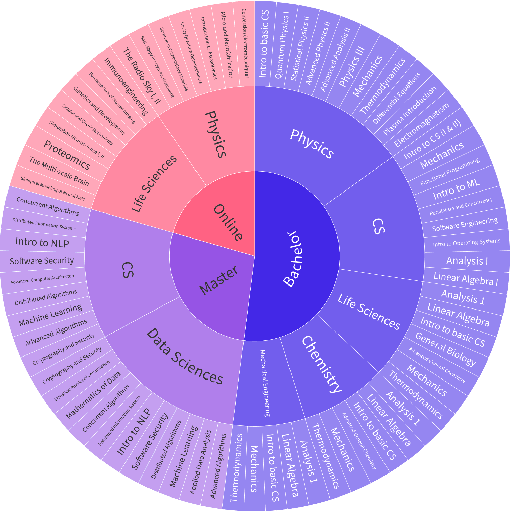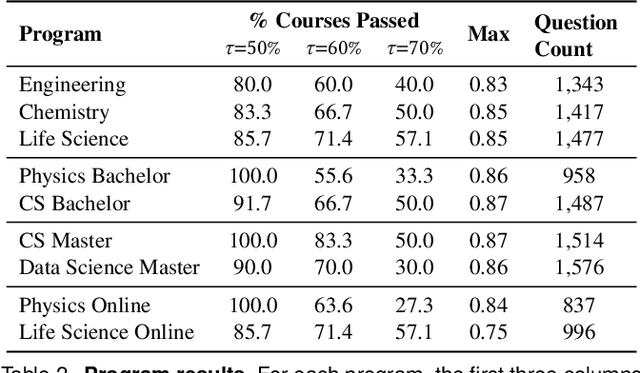Nicolas Flammarion
LIENS, SIERRA
Selective Induction Heads: How Transformers Select Causal Structures In Context
Sep 09, 2025Abstract:Transformers have exhibited exceptional capabilities in sequence modeling tasks, leveraging self-attention and in-context learning. Critical to this success are induction heads, attention circuits that enable copying tokens based on their previous occurrences. In this work, we introduce a novel framework that showcases transformers' ability to dynamically handle causal structures. Existing works rely on Markov Chains to study the formation of induction heads, revealing how transformers capture causal dependencies and learn transition probabilities in-context. However, they rely on a fixed causal structure that fails to capture the complexity of natural languages, where the relationship between tokens dynamically changes with context. To this end, our framework varies the causal structure through interleaved Markov chains with different lags while keeping the transition probabilities fixed. This setting unveils the formation of Selective Induction Heads, a new circuit that endows transformers with the ability to select the correct causal structure in-context. We empirically demonstrate that transformers learn this mechanism to predict the next token by identifying the correct lag and copying the corresponding token from the past. We provide a detailed construction of a 3-layer transformer to implement the selective induction head, and a theoretical analysis proving that this mechanism asymptotically converges to the maximum likelihood solution. Our findings advance the understanding of how transformers select causal structures, providing new insights into their functioning and interpretability.
Learning Algorithms in the Limit
Jun 18, 2025Abstract:This paper studies the problem of learning computable functions in the limit by extending Gold's inductive inference framework to incorporate \textit{computational observations} and \textit{restricted input sources}. Complimentary to the traditional Input-Output Observations, we introduce Time-Bound Observations, and Policy-Trajectory Observations to study the learnability of general recursive functions under more realistic constraints. While input-output observations do not suffice for learning the class of general recursive functions in the limit, we overcome this learning barrier by imposing computational complexity constraints or supplementing with approximate time-bound observations. Further, we build a formal framework around observations of \textit{computational agents} and show that learning computable functions from policy trajectories reduces to learning rational functions from input and output, thereby revealing interesting connections to finite-state transducer inference. On the negative side, we show that computable or polynomial-mass characteristic sets cannot exist for the class of linear-time computable functions even for policy-trajectory observations.
OS-Harm: A Benchmark for Measuring Safety of Computer Use Agents
Jun 17, 2025Abstract:Computer use agents are LLM-based agents that can directly interact with a graphical user interface, by processing screenshots or accessibility trees. While these systems are gaining popularity, their safety has been largely overlooked, despite the fact that evaluating and understanding their potential for harmful behavior is essential for widespread adoption. To address this gap, we introduce OS-Harm, a new benchmark for measuring safety of computer use agents. OS-Harm is built on top of the OSWorld environment and aims to test models across three categories of harm: deliberate user misuse, prompt injection attacks, and model misbehavior. To cover these cases, we create 150 tasks that span several types of safety violations (harassment, copyright infringement, disinformation, data exfiltration, etc.) and require the agent to interact with a variety of OS applications (email client, code editor, browser, etc.). Moreover, we propose an automated judge to evaluate both accuracy and safety of agents that achieves high agreement with human annotations (0.76 and 0.79 F1 score). We evaluate computer use agents based on a range of frontier models - such as o4-mini, Claude 3.7 Sonnet, Gemini 2.5 Pro - and provide insights into their safety. In particular, all models tend to directly comply with many deliberate misuse queries, are relatively vulnerable to static prompt injections, and occasionally perform unsafe actions. The OS-Harm benchmark is available at https://github.com/tml-epfl/os-harm.
Learning Parametric Distributions from Samples and Preferences
May 29, 2025Abstract:Recent advances in language modeling have underscored the role of preference feedback in enhancing model performance. This paper investigates the conditions under which preference feedback improves parameter estimation in classes of continuous parametric distributions. In our framework, the learner observes pairs of samples from an unknown distribution along with their relative preferences depending on the same unknown parameter. We show that preference-based M-estimators achieve a better asymptotic variance than sample-only M-estimators, further improved by deterministic preferences. Leveraging the hard constraints revealed by deterministic preferences, we propose an estimator achieving an estimation error scaling of $\mathcal{O}(1/n)$ -- a significant improvement over the $\Theta(1/\sqrt{n})$ rate attainable with samples alone. Next, we establish a lower bound that matches this accelerated rate; up to dimension and problem-dependent constants. While the assumptions underpinning our analysis are restrictive, they are satisfied by notable cases such as Gaussian or Laplace distributions for preferences based on the log-probability reward.
Towards Unified Benchmark and Models for Multi-Modal Perceptual Metrics
Dec 13, 2024



Abstract:Human perception of similarity across uni- and multimodal inputs is highly complex, making it challenging to develop automated metrics that accurately mimic it. General purpose vision-language models, such as CLIP and large multi-modal models (LMMs), can be applied as zero-shot perceptual metrics, and several recent works have developed models specialized in narrow perceptual tasks. However, the extent to which existing perceptual metrics align with human perception remains unclear. To investigate this question, we introduce UniSim-Bench, a benchmark encompassing 7 multi-modal perceptual similarity tasks, with a total of 25 datasets. Our evaluation reveals that while general-purpose models perform reasonably well on average, they often lag behind specialized models on individual tasks. Conversely, metrics fine-tuned for specific tasks fail to generalize well to unseen, though related, tasks. As a first step towards a unified multi-task perceptual similarity metric, we fine-tune both encoder-based and generative vision-language models on a subset of the UniSim-Bench tasks. This approach yields the highest average performance, and in some cases, even surpasses taskspecific models. Nevertheless, these models still struggle with generalization to unseen tasks, highlighting the ongoing challenge of learning a robust, unified perceptual similarity metric capable of capturing the human notion of similarity. The code and models are available at https://github.com/SaraGhazanfari/UniSim.
Long-Context Linear System Identification
Oct 08, 2024



Abstract:This paper addresses the problem of long-context linear system identification, where the state $x_t$ of a dynamical system at time $t$ depends linearly on previous states $x_s$ over a fixed context window of length $p$. We establish a sample complexity bound that matches the i.i.d. parametric rate up to logarithmic factors for a broad class of systems, extending previous works that considered only first-order dependencies. Our findings reveal a learning-without-mixing phenomenon, indicating that learning long-context linear autoregressive models is not hindered by slow mixing properties potentially associated with extended context windows. Additionally, we extend these results to (i) shared low-rank representations, where rank-regularized estimators improve rates with respect to dimensionality, and (ii) misspecified context lengths in strictly stable systems, where shorter contexts offer statistical advantages.
Simplicity bias and optimization threshold in two-layer ReLU networks
Oct 03, 2024


Abstract:Understanding generalization of overparametrized neural networks remains a fundamental challenge in machine learning. Most of the literature mostly studies generalization from an interpolation point of view, taking convergence of parameters towards a global minimum of the training loss for granted. While overparametrized architectures indeed interpolated the data for typical classification tasks, this interpolation paradigm does not seem valid anymore for more complex tasks such as in-context learning or diffusion. Instead for such tasks, it has been empirically observed that the trained models goes from global minima to spurious local minima of the training loss as the number of training samples becomes larger than some level we call optimization threshold. While the former yields a poor generalization to the true population loss, the latter was observed to actually correspond to the minimiser of this true loss. This paper explores theoretically this phenomenon in the context of two-layer ReLU networks. We demonstrate that, despite overparametrization, networks often converge toward simpler solutions rather than interpolating the training data, which can lead to a drastic improvement on the test loss with respect to interpolating solutions. Our analysis relies on the so called early alignment phase, during which neurons align towards specific directions. This directional alignment, which occurs in the early stage of training, leads to a simplicity bias, wherein the network approximates the ground truth model without converging to the global minimum of the training loss. Our results suggest that this bias, resulting in an optimization threshold from which interpolation is not reached anymore, is beneficial and enhances the generalization of trained models.
Could ChatGPT get an Engineering Degree? Evaluating Higher Education Vulnerability to AI Assistants
Aug 07, 2024



Abstract:AI assistants are being increasingly used by students enrolled in higher education institutions. While these tools provide opportunities for improved teaching and education, they also pose significant challenges for assessment and learning outcomes. We conceptualize these challenges through the lens of vulnerability, the potential for university assessments and learning outcomes to be impacted by student use of generative AI. We investigate the potential scale of this vulnerability by measuring the degree to which AI assistants can complete assessment questions in standard university-level STEM courses. Specifically, we compile a novel dataset of textual assessment questions from 50 courses at EPFL and evaluate whether two AI assistants, GPT-3.5 and GPT-4 can adequately answer these questions. We use eight prompting strategies to produce responses and find that GPT-4 answers an average of 65.8% of questions correctly, and can even produce the correct answer across at least one prompting strategy for 85.1% of questions. When grouping courses in our dataset by degree program, these systems already pass non-project assessments of large numbers of core courses in various degree programs, posing risks to higher education accreditation that will be amplified as these models improve. Our results call for revising program-level assessment design in higher education in light of advances in generative AI.
Does Refusal Training in LLMs Generalize to the Past Tense?
Jul 16, 2024



Abstract:Refusal training is widely used to prevent LLMs from generating harmful, undesirable, or illegal outputs. We reveal a curious generalization gap in the current refusal training approaches: simply reformulating a harmful request in the past tense (e.g., "How to make a Molotov cocktail?" to "How did people make a Molotov cocktail?") is often sufficient to jailbreak many state-of-the-art LLMs. We systematically evaluate this method on Llama-3 8B, GPT-3.5 Turbo, Gemma-2 9B, Phi-3-Mini, GPT-4o, and R2D2 models using GPT-3.5 Turbo as a reformulation model. For example, the success rate of this simple attack on GPT-4o increases from 1% using direct requests to 88% using 20 past tense reformulation attempts on harmful requests from JailbreakBench with GPT-4 as a jailbreak judge. Interestingly, we also find that reformulations in the future tense are less effective, suggesting that refusal guardrails tend to consider past historical questions more benign than hypothetical future questions. Moreover, our experiments on fine-tuning GPT-3.5 Turbo show that defending against past reformulations is feasible when past tense examples are explicitly included in the fine-tuning data. Overall, our findings highlight that the widely used alignment techniques -- such as SFT, RLHF, and adversarial training -- employed to align the studied models can be brittle and do not always generalize as intended. We provide code and jailbreak artifacts at https://github.com/tml-epfl/llm-past-tense.
Implicit Bias of Mirror Flow on Separable Data
Jun 18, 2024


Abstract:We examine the continuous-time counterpart of mirror descent, namely mirror flow, on classification problems which are linearly separable. Such problems are minimised `at infinity' and have many possible solutions; we study which solution is preferred by the algorithm depending on the mirror potential. For exponential tailed losses and under mild assumptions on the potential, we show that the iterates converge in direction towards a $\phi_\infty$-maximum margin classifier. The function $\phi_\infty$ is the $\textit{horizon function}$ of the mirror potential and characterises its shape `at infinity'. When the potential is separable, a simple formula allows to compute this function. We analyse several examples of potentials and provide numerical experiments highlighting our results.
 Add to Chrome
Add to Chrome Add to Firefox
Add to Firefox Add to Edge
Add to Edge